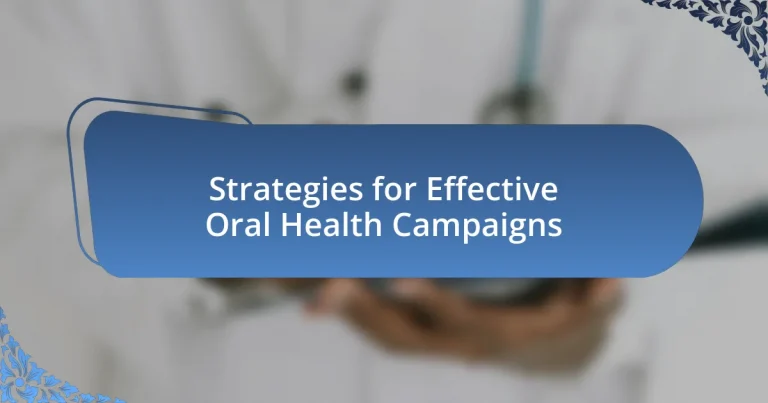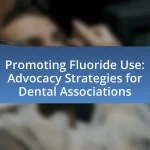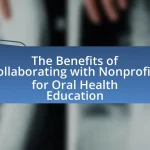The article focuses on strategies for effective oral health campaigns, emphasizing key components such as clear messaging, targeted audience engagement, accessibility of resources, and outcome evaluation. It explores how understanding demographics influences campaign strategies, the importance of emotional appeal in messaging, and the effectiveness of various communication channels, including social media and community partnerships. Additionally, the article addresses challenges faced by campaigns, such as misinformation and budget constraints, while providing practical tips for enhancing success and maintaining engagement over time. Overall, it highlights the significance of tailored approaches to improve oral health awareness and outcomes within communities.
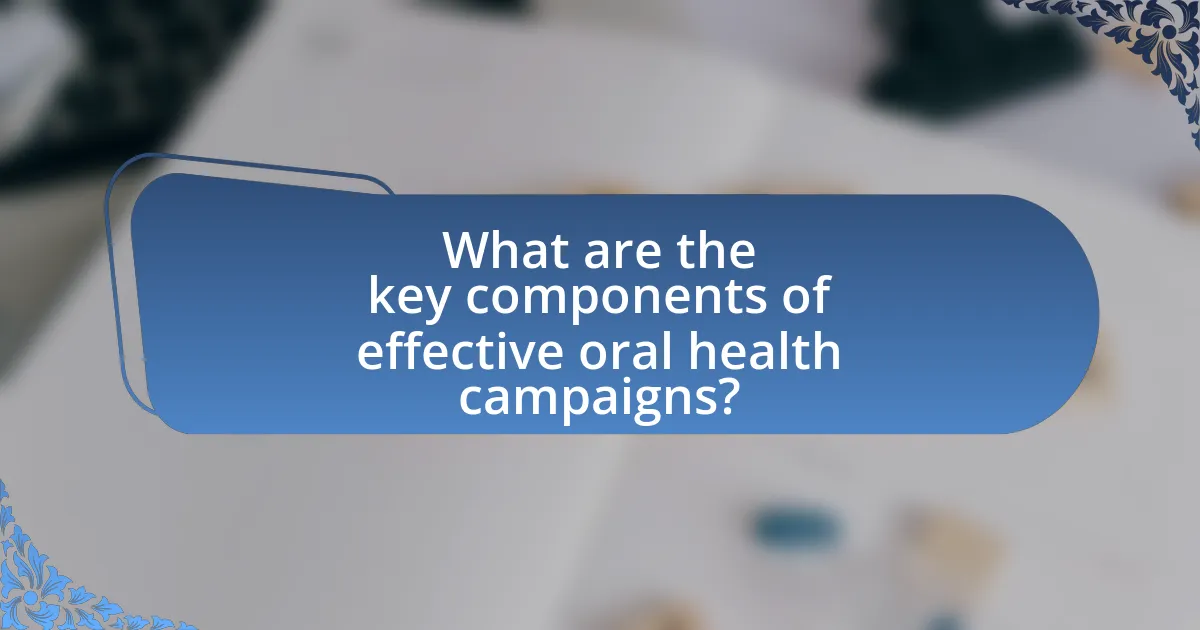
What are the key components of effective oral health campaigns?
The key components of effective oral health campaigns include clear messaging, targeted audience engagement, accessibility of resources, and evaluation of outcomes. Clear messaging ensures that the information is understandable and resonates with the audience, while targeted audience engagement involves identifying specific demographics to tailor the campaign effectively. Accessibility of resources, such as providing free dental check-ups or educational materials, increases participation and awareness. Lastly, evaluating outcomes through surveys or health metrics helps in assessing the campaign’s impact and making necessary adjustments for future initiatives. These components are supported by studies indicating that campaigns with these elements achieve higher levels of community participation and improved oral health outcomes.
How do target audiences influence campaign strategies?
Target audiences significantly influence campaign strategies by dictating the messaging, channels, and tactics used to engage them effectively. Understanding the demographics, preferences, and behaviors of the target audience allows campaign designers to tailor content that resonates, ensuring higher engagement and effectiveness. For instance, a study published in the Journal of Health Communication found that campaigns targeting specific age groups with relevant messaging resulted in a 30% increase in participation rates compared to generic approaches. This demonstrates that aligning campaign strategies with the characteristics of the target audience leads to more successful outcomes in oral health initiatives.
What demographics should be considered when designing campaigns?
When designing campaigns, key demographics to consider include age, gender, income level, education, geographic location, and cultural background. Age influences health behaviors and preferences; for instance, children may require different messaging than adults. Gender can affect health perceptions and access to care, while income level often correlates with access to dental services. Education impacts health literacy, which is crucial for understanding oral health information. Geographic location can determine the availability of resources and cultural background shapes attitudes towards oral health practices. Research indicates that tailored messaging based on these demographics can significantly enhance campaign effectiveness, as seen in studies that demonstrate improved health outcomes when campaigns address specific community needs and characteristics.
How can audience needs shape messaging and outreach?
Audience needs can significantly shape messaging and outreach by ensuring that communication is relevant, engaging, and tailored to specific demographics. Understanding the audience’s preferences, concerns, and cultural contexts allows for the development of targeted messages that resonate more effectively. For instance, research indicates that campaigns addressing specific community health issues, such as high rates of dental caries in low-income populations, can lead to increased engagement and participation. By utilizing data from surveys or focus groups, health communicators can identify key messages that address the unique barriers and motivations of their audience, thereby enhancing the overall impact of oral health campaigns.
What role does messaging play in oral health campaigns?
Messaging plays a crucial role in oral health campaigns by effectively communicating key information and influencing behavior change among target audiences. Clear and targeted messaging helps to raise awareness about oral health issues, educate individuals on preventive measures, and motivate them to adopt healthier habits. For instance, campaigns that utilize relatable language and culturally relevant content have been shown to increase engagement and understanding, leading to improved oral health outcomes. Research indicates that campaigns with strong messaging can lead to a 20% increase in dental visits among targeted populations, demonstrating the significant impact of effective communication strategies in promoting oral health.
What types of messages resonate most with audiences?
Messages that resonate most with audiences are those that are emotionally engaging, relatable, and provide clear benefits. Research indicates that messages emphasizing personal stories or testimonials can significantly enhance audience connection, as they evoke empathy and relatability. For instance, a study published in the Journal of Health Communication found that narratives about individuals overcoming oral health challenges led to increased motivation for preventive behaviors among participants. Additionally, messages that highlight the positive outcomes of good oral health, such as improved self-esteem and social interactions, tend to be more persuasive. This evidence supports the effectiveness of emotionally charged and benefit-oriented messaging in oral health campaigns.
How can emotional appeal enhance campaign effectiveness?
Emotional appeal can enhance campaign effectiveness by creating a deeper connection with the audience, leading to increased engagement and motivation to act. Campaigns that evoke emotions such as empathy, fear, or joy can significantly influence behavior; for instance, a study published in the Journal of Advertising Research found that emotionally charged advertisements are 23 times more effective in driving consumer action than those that are purely informational. This connection fosters trust and relatability, making the campaign’s message more memorable and impactful.
What channels are most effective for disseminating oral health information?
The most effective channels for disseminating oral health information include social media, community outreach programs, and healthcare provider recommendations. Social media platforms, such as Facebook and Instagram, allow for wide-reaching engagement and targeted messaging, making them ideal for reaching diverse populations. Community outreach programs, including school-based initiatives and local health fairs, facilitate direct interaction and education, enhancing understanding and retention of oral health information. Healthcare provider recommendations are crucial, as patients often trust and follow advice from their dental professionals, leading to improved health outcomes. Studies show that combining these channels increases the overall effectiveness of oral health campaigns, as they leverage both digital and personal interactions to maximize reach and impact.
How do traditional media compare to digital platforms in reach?
Traditional media generally have a more limited reach compared to digital platforms. While traditional media such as television, radio, and print can reach broad audiences, their effectiveness is often constrained by geographic and demographic factors. In contrast, digital platforms like social media, websites, and email marketing can target specific audiences globally, allowing for more personalized and extensive outreach. For instance, as of 2023, social media platforms have billions of active users, enabling campaigns to reach diverse demographics instantaneously, whereas traditional media often relies on scheduled broadcasts or print runs that may not reach all intended audiences.
What role do social media influencers play in oral health campaigns?
Social media influencers play a crucial role in oral health campaigns by leveraging their reach and credibility to promote oral hygiene practices and products. They engage audiences through relatable content, making oral health information more accessible and appealing. For instance, studies show that campaigns featuring influencers can increase engagement rates by up to 60%, significantly enhancing awareness and behavioral change regarding oral health. Their ability to connect with diverse demographics allows for tailored messaging that resonates with specific groups, ultimately driving positive health outcomes.
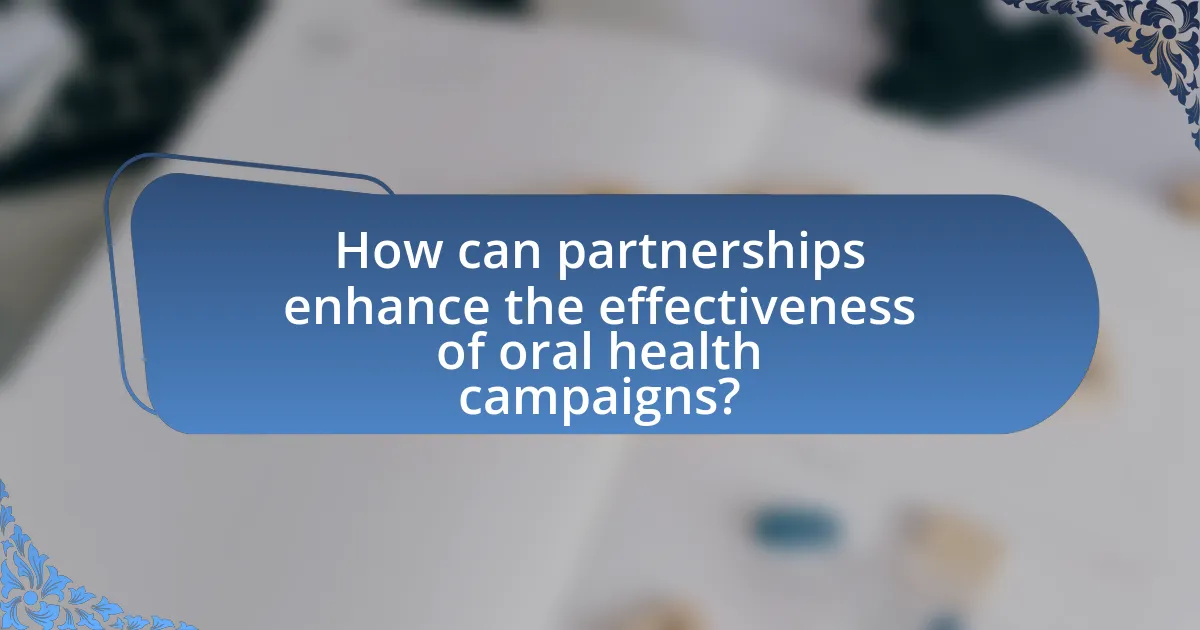
How can partnerships enhance the effectiveness of oral health campaigns?
Partnerships can enhance the effectiveness of oral health campaigns by leveraging diverse resources, expertise, and networks to reach broader audiences. Collaborations between public health organizations, dental associations, schools, and community groups can amplify messaging and increase engagement. For instance, a study published in the Journal of Public Health Dentistry found that community-based partnerships significantly improved access to dental care and increased awareness of oral health issues among underserved populations. By combining efforts, these partnerships can create comprehensive strategies that address various aspects of oral health, ultimately leading to improved health outcomes.
What types of organizations should be involved in partnerships?
Health organizations, educational institutions, non-profits, and private sector companies should be involved in partnerships for effective oral health campaigns. Health organizations provide expertise and resources for clinical practices, while educational institutions can facilitate research and outreach programs. Non-profits often have established community connections and can mobilize volunteers, enhancing campaign reach. Private sector companies can contribute funding and innovative solutions, making the partnership more sustainable. Collaborating across these types of organizations ensures a comprehensive approach to addressing oral health issues, leveraging diverse strengths for greater impact.
How can local health departments contribute to campaign success?
Local health departments can significantly contribute to campaign success by leveraging their community connections and expertise in public health. They can facilitate outreach efforts, ensuring that campaigns are tailored to meet the specific needs of the population they serve. For instance, local health departments often have access to demographic data and health statistics, which can inform campaign strategies and messaging. Additionally, they can provide resources such as educational materials, training for community health workers, and venues for events, enhancing the campaign’s visibility and impact. Studies have shown that campaigns supported by local health departments tend to achieve higher engagement rates, as these departments are trusted sources of health information within their communities.
What benefits do collaborations with schools provide?
Collaborations with schools provide enhanced access to students for health education initiatives. These partnerships facilitate the implementation of oral health campaigns directly within the school environment, allowing for targeted messaging and engagement with children and their families. Research indicates that school-based programs can significantly improve children’s oral health knowledge and behaviors, as evidenced by a study published in the Journal of School Health, which found that students participating in school-based oral health education showed a 25% increase in knowledge about dental hygiene practices. Additionally, collaborations can leverage school resources, such as facilities and staff, to maximize outreach and effectiveness, ultimately leading to improved health outcomes in the community.
How can community engagement improve campaign outcomes?
Community engagement can significantly improve campaign outcomes by fostering trust and collaboration between campaign organizers and the target audience. Engaged communities are more likely to participate actively, share information, and support initiatives, leading to higher awareness and participation rates. For instance, a study published in the Journal of Public Health found that community-driven health campaigns saw a 30% increase in participation compared to top-down approaches. This demonstrates that when communities feel involved and valued, they contribute more effectively to the success of health campaigns, ultimately resulting in better health outcomes and sustained behavioral changes.
What strategies can be used to involve community members?
To involve community members in oral health campaigns, strategies such as community engagement, partnerships with local organizations, and participatory planning can be employed. Community engagement fosters trust and encourages participation by involving members in decision-making processes. Collaborating with local organizations, such as schools and health clinics, enhances outreach and resource sharing, making campaigns more effective. Participatory planning allows community members to contribute their insights and preferences, ensuring that the campaign addresses their specific needs and concerns. Research shows that campaigns utilizing these strategies see increased participation and improved health outcomes, as evidenced by a study published in the Journal of Community Health, which found that community-driven initiatives led to a 30% increase in oral health awareness in targeted populations.
How does feedback from the community shape future campaigns?
Feedback from the community directly influences the design and execution of future campaigns by providing insights into the needs, preferences, and concerns of the target audience. This feedback allows campaign planners to tailor messaging, identify effective communication channels, and adjust strategies to enhance engagement and impact. For instance, a study published in the Journal of Public Health found that campaigns incorporating community feedback saw a 30% increase in participation rates compared to those that did not. By actively listening to community input, organizations can ensure that their campaigns resonate more effectively, ultimately leading to improved health outcomes.
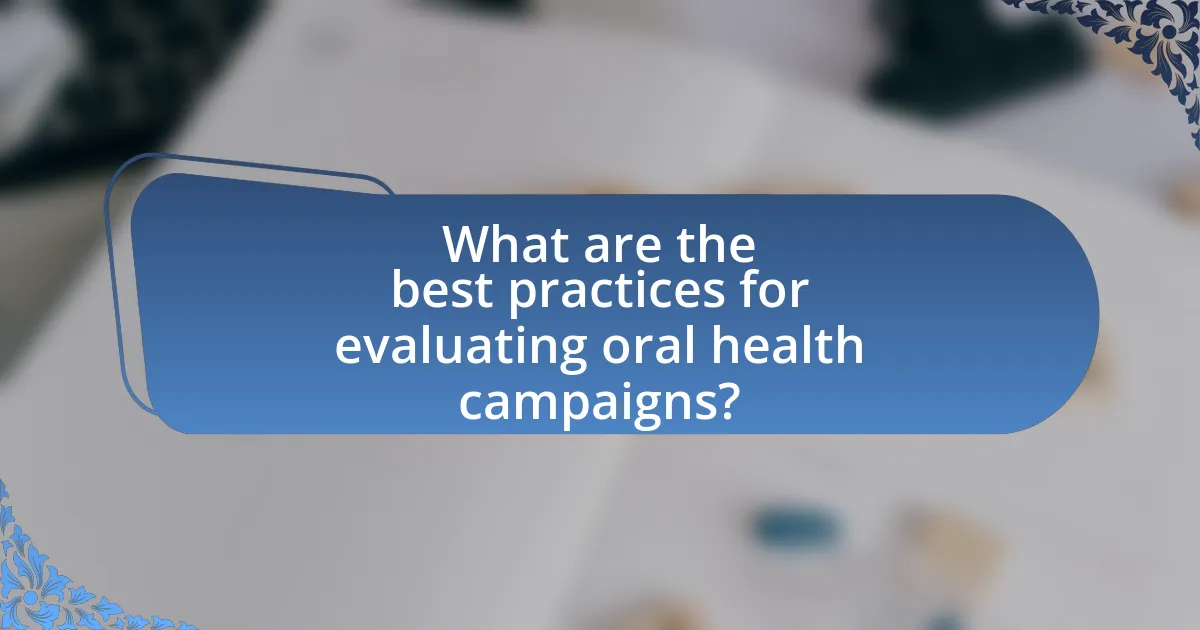
What are the best practices for evaluating oral health campaigns?
The best practices for evaluating oral health campaigns include setting clear objectives, utilizing both qualitative and quantitative methods, and engaging stakeholders throughout the evaluation process. Clear objectives provide a framework for measuring success, while qualitative methods, such as focus groups, and quantitative methods, such as surveys, offer comprehensive insights into the campaign’s impact. Engaging stakeholders, including community members and health professionals, ensures that the evaluation reflects diverse perspectives and enhances the relevance of findings. Research indicates that campaigns with well-defined goals and mixed-method evaluations yield more actionable insights, as demonstrated in studies like “Evaluating Health Promotion Programs: A Guide for Practitioners” by the Centers for Disease Control and Prevention, which emphasizes the importance of these practices in achieving effective health outcomes.
What metrics should be used to assess campaign effectiveness?
To assess campaign effectiveness, key metrics include reach, engagement, conversion rates, and return on investment (ROI). Reach measures the total number of individuals exposed to the campaign, indicating its visibility. Engagement tracks interactions such as likes, shares, and comments, reflecting audience interest and involvement. Conversion rates quantify the percentage of individuals who take a desired action, such as scheduling a dental appointment, demonstrating the campaign’s impact on behavior. ROI evaluates the financial return relative to the campaign costs, providing insight into overall effectiveness. These metrics collectively offer a comprehensive view of how well an oral health campaign achieves its objectives.
How can pre- and post-campaign surveys provide valuable insights?
Pre- and post-campaign surveys provide valuable insights by measuring changes in knowledge, attitudes, and behaviors regarding oral health before and after a campaign. These surveys allow campaign organizers to assess the effectiveness of their messaging and strategies, identifying areas of improvement and success. For instance, a study published in the Journal of Public Health Dentistry found that pre- and post-campaign surveys significantly highlighted increased awareness and behavioral changes among participants, demonstrating the direct impact of targeted oral health campaigns.
What role does data analysis play in refining strategies?
Data analysis plays a crucial role in refining strategies by providing insights that inform decision-making processes. Through the examination of data, organizations can identify trends, measure the effectiveness of current strategies, and pinpoint areas for improvement. For instance, a study published in the Journal of Public Health Dentistry found that data-driven campaigns in oral health significantly increased community engagement and awareness by 30% compared to non-data-driven approaches. This demonstrates that leveraging data analysis not only enhances the precision of strategies but also leads to more effective outcomes in oral health initiatives.
What common challenges do oral health campaigns face?
Oral health campaigns commonly face challenges such as limited funding, public apathy, and misinformation. Limited funding restricts the reach and effectiveness of campaigns, making it difficult to implement comprehensive strategies. Public apathy often results from a lack of awareness about the importance of oral health, leading to low engagement levels. Misinformation, particularly regarding dental care practices, can mislead the public and undermine campaign efforts. These challenges are supported by studies indicating that financial constraints and public perception significantly impact the success of health initiatives.
How can misinformation be addressed in campaigns?
Misinformation in campaigns can be addressed through fact-checking, clear communication, and community engagement. Fact-checking involves verifying claims before dissemination, which helps to ensure that only accurate information is shared. Clear communication entails using straightforward language and visuals to convey messages effectively, reducing the chances of misinterpretation. Community engagement fosters trust and allows for direct dialogue, enabling campaigners to clarify misconceptions and provide evidence-based information. Research indicates that campaigns employing these strategies are more successful in changing public perceptions and behaviors regarding health issues, as seen in studies like the one conducted by the American Public Health Association, which highlights the effectiveness of accurate messaging in public health campaigns.
What strategies can mitigate budget constraints?
To mitigate budget constraints in oral health campaigns, organizations can implement cost-effective strategies such as leveraging partnerships, utilizing digital marketing, and prioritizing high-impact interventions. Partnerships with local health organizations or businesses can share resources and reduce costs, as evidenced by the collaboration between the American Dental Association and local health departments, which has shown to enhance outreach while minimizing expenses. Digital marketing, including social media campaigns, allows for broad reach at a lower cost compared to traditional advertising methods, with studies indicating that social media can increase engagement by up to 80% for health initiatives. Additionally, focusing on high-impact interventions, such as community education programs that have demonstrated a significant return on investment, can ensure that limited funds are allocated to the most effective strategies.
What practical tips can enhance the success of oral health campaigns?
To enhance the success of oral health campaigns, it is essential to engage the target audience through tailored messaging and community involvement. Tailored messaging ensures that the information resonates with specific demographics, increasing the likelihood of behavior change. For instance, campaigns that use relatable language and culturally relevant examples have shown higher engagement rates. Community involvement, such as partnering with local organizations and influencers, fosters trust and encourages participation. Research indicates that campaigns incorporating local stakeholders can improve outreach effectiveness by up to 50%. Additionally, utilizing multiple communication channels, including social media, workshops, and school programs, broadens reach and reinforces key messages.
How can campaigns ensure cultural sensitivity in messaging?
Campaigns can ensure cultural sensitivity in messaging by conducting thorough research on the target audience’s cultural backgrounds and values. Understanding cultural nuances allows campaigns to tailor their messages in a way that resonates with diverse communities, avoiding stereotypes and misrepresentations. For instance, a study published in the Journal of Health Communication highlights that culturally tailored health messages significantly improve engagement and effectiveness among minority populations. By incorporating feedback from community leaders and representatives during the message development process, campaigns can further enhance their cultural relevance and acceptance.
What are effective ways to maintain engagement over time?
Effective ways to maintain engagement over time include regular communication, personalized content, and interactive elements. Regular communication, such as newsletters or updates, keeps the audience informed and connected. Personalized content, tailored to individual preferences and needs, enhances relevance and fosters a deeper connection. Interactive elements, like quizzes or surveys, encourage participation and feedback, making the audience feel valued. Research shows that campaigns incorporating these strategies see higher retention rates and sustained interest, as evidenced by a study published in the Journal of Health Communication, which found that personalized messaging increased engagement by 30%.
